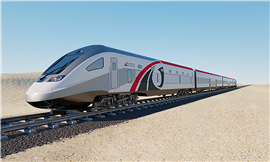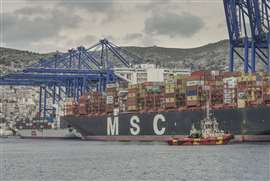Can dreams of a new India-Middle East-Europe Corridor stay on track?
20 October 2023
Ambitious plans announced on the sidelines of the G20 summit in September could see the construction of high-speed rail links across the Arabian Peninsula to form the backbone of a multibillion trade corridor designed to link India to Europe and to challenge China’s Belt & Road initiative. Lucy Barnard reports.
Rushing past the striking orange sand dunes of the Arabian Desert, the high-speed trains linking the first stage of the UAE’s new Etihad Rail service seem little more than a blur in the intense shimmering heat.
The train line, which opened in 2016, linking the inland gas fields of Shah and Habshan with the oil refinery at Ruwais, each day carries up to 22,000 tonnes of granulated sulphur to the processing and export point along a 264-kilometer route.
A second stage of the railway, linking the small town of Ghuwaifat on the UAE’s western border with Saudi Arabia to Fujaira on its eastern coast, stretching for a total of 605km, opened to freight trains in February 2023.
 Image: Etihad Rail
Image: Etihad Rail
And, if ambitious political plans announced on the sidelines of the G20 summit in September go ahead, these trains through the desert could soon form the backbone of a multibillion trade corridor designed to link India to Europe and to challenge China’s Belt & Road initiative.
The new initiative, dubbed the India-Middle East – Europe Corridor (IMEEC) aims to provide a quick and reliable route for goods to travel from India to Europe. Goods from India will travel by sea from India to the ports of the UAE and Saudi Arabia where they will be seamlessly transferred to high-speed trains which will then whizz them across the Arabian Peninsula to the Mediterranean where they will again be seamlessly transferred by ship to EU ports in Greece, Italy and France.
“This is a big deal. This is a really big deal,” said US President Joe Biden, announcing an official agreement between Saudi Arabia, the European Union, India, the UAE, France, Germany, Italy and the USA.
“The India – Middle East – Europe corridor proposed during the summit will become a basis of world trade for hundreds of years,” added Indian prime minister Narendra Modi.
For many, the concept makes perfect sense. Much of the infrastructure required has already been built or is currently in progress. The ports of Mundra in India, Jebel Ali in the UAE, Haifa in Israel and Piraeus in Greece have all seen recent upgrades.
Where will the IMEEC go?
Moreover, the plan coincides with the biggest railway building programme and revival in the Arabian Peninsula since the colonial era. As well as freight services starting in the UAE, a new 1,242 km railway line between the Saudi capital Riyadh and the northern Saudi city of Qurayyat near the Jordanian border, built at an estimated cost of SAR20 billion (US$5.3 billion), was completed in 2011. The Saudi government is also planning to build a high-speed rail line from the Red Sea port of Jeddah, via Riyadh to Damman on its Gulf coast which could also, one day, form part of the corridor.
“I think there is huge potential to make the India-Middle East-Europe Economic Corridor happen,” says Chandrasekhar Panda, a partner in McKinsey’s Middle East office.
“Firstly, it makes sense commercially. Second, much of the infrastructure is already there and can be reused so it is not reinventing the wheel. And thirdly, it helps all the stakeholders and parties who stand to benefit. It will create a major supply chain ecosystem around which additional clusters can be built.”
Currently goods travelling from India to Europe either travel as air cargo, or more frequently are shipped around the Arabian Peninsula, up the Red Sea and through the Suez Canal to Mediterranean Ports.
 The Greek Port of Piraeus. Photo: Imago Images via Reuters
The Greek Port of Piraeus. Photo: Imago Images via Reuters
As part of that journey, the biggest bottleneck is the Suez Canal. Each year around 12% of international trade passes through the canal, the shortest maritime route between Asia and Europe. In 2021, the container ship Ever Given ran aground in the canal, remaining in place for six days before salvage crews were able to free her and disrupting international trade for months. The strategic Strait of Hormuz at the entrance to the Gulf acts as another potential chokepoint.
“All of us remember what happened two and a half years back when the entire traffic corridor got choked, and already the Suez Canal has become quite saturated with trade, highlighting the potential opportunity for additional paths,” Panda says. “The land/sea corridor between India and the Middle East is not being used to its full potential. Using this route could result in shipping times from India to Europe, on average, being reduced by around 40%.”
At the G20 meeting, Amos Hochstein, Biden’s coordinator for global infrastructure and energy security said that working groups from each of the countries are putting together a fuller plan to identify areas where existing infrastructure can be connected and identifying areas which need investment which they aim to publish by 30 November.
Certainly, creating the infrastructure for an alternative trade route to the Suez Canal would likely entail lucrative rail and port expansion projects for contractors.
Norwegian contractor Kvaerner Construction was one of the firms working on the construction of Mutra Port. Dutch dredging specialist Boskalis, Greek Archirodon and Korean Hyundai Engineering worked on Abu Dhabi’s Khalifa Port. Dutch construction giant BAM and a joint ventures including UK-based Balfour Beatty worked on the fourth terminal at Jebel Ali port in Dubai.
Who stands to benefit from the IMEEC?
US-based Louis Berger Group and French SYSTRA carried out the main construction work on Saudi Arabia’s US$140m north-south railway, alongside Saudi Consolidated Engineering. The UAE’s Etihad Rail has been built in various packages by construction firms from around the globe including China State Construction Engineering Corporation and China Railway Construction Corporation.
“For this kind of infrastructure project, we expect that each country is likely to create one national mega package for the work,” says Panda. “These things need to be done on a national basis because they require local regulation and land acquisition and other things. Then there will be sub-packages for specific works.”
But others point out that, despite the optimism, the mega project faces significant challenges – most significantly from the politics that such an enormous trade undertaking necessarily entails, especially in the war-torn Middle East.
 Chandrasekhar Panda, partner at McKinsey & Co. Photo: McKinsey
Chandrasekhar Panda, partner at McKinsey & Co. Photo: McKinsey
One of the biggest problems is constructing a railway line between Saudi Arabia and Israel which share no land borders. For freight trains to connect to the Israeli port of Haifa, they would need to pass through Jordan, a country extremely wary of becoming part of such a link. Recent violence in Israel is likely to cause further strains on diplomatic relations in the Middle East as a whole.
Financing the new trade corridor is also likely to be problematic. So far, the partners have suggested that, unlike China’s Belt & Road Initiative which is underwritten by the Chinese State, the IMEEC would be a component of the G7’s Partnership for Global Infrastructure & Investment which relies on private sector investments.
“Undeniably, a project of such massive financial commitment involving many countries having their own resource challenges besides economic viability issues will require a tremendous amount of coordination and political will to implement,” says Vinod Rai, a research fellow at the National University of Singapore. “The US and the EU are facing protracted difficulties due to the long-drawn conflict in Ukraine, which does not seem to be ending soon. The German economy, which has been the engine of European growth, has shown signs of stagnation. The fact that Iran and Turkey are not a part of the project may pose its own challenges, especially since Iran’s Chabahar port has been facing headwinds due to continuing US sanctions.”
“The greater concern now is the recent Hamas attack on Israel, which is bound to see retaliation and protracted hostilities,” he adds. “The US has been engaged in backdoor negotiations to normalise relations between Saudi Arabia and Israel such that Saudi Arabia would get Western assistance to build a rail network to obtain access to Israel’s Haifa port through Jordan. The hostilities will be a setback to the progress made on the deal.”
STAY CONNECTED



Receive the information you need when you need it through our world-leading magazines, newsletters and daily briefings.
CONNECT WITH THE TEAM








